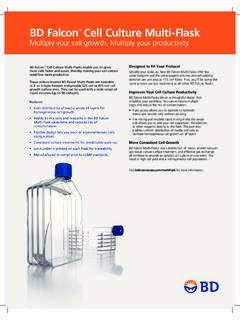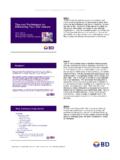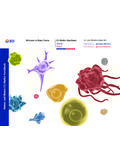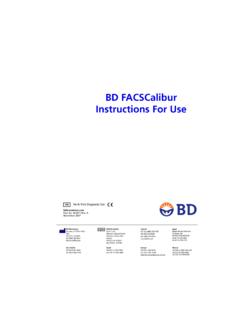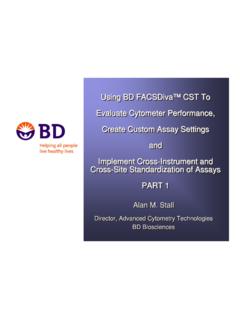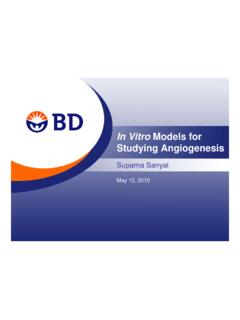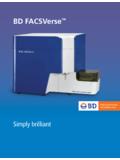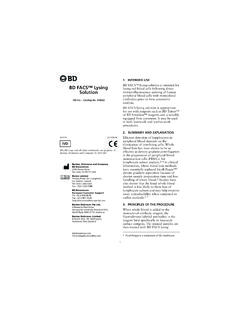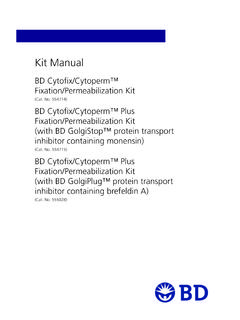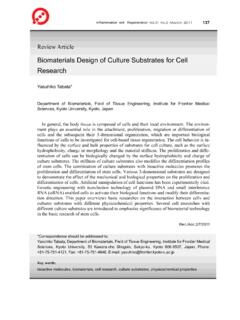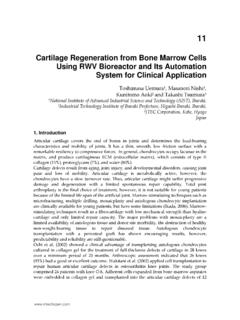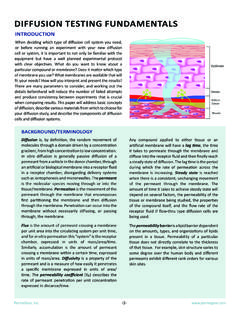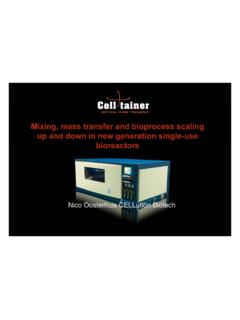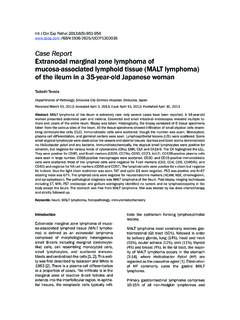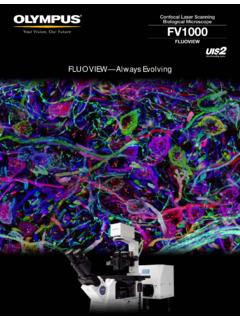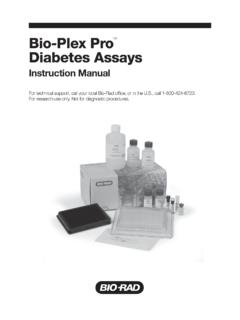Transcription of 3D Cell Culture Systems - BD Biosciences
1 3d cell culture Systems Marshall J. Kosovsky, BD Biosciences February 16, 2011. Topics for Discussion Overview of Cell Culture Systems : 2D vs. 3D. Extracellular Matrix (ECM) Proteins Epithelial cell differentiation Endothelial cell tube formation Animal-Free Matrix: BD PuraMatrix Peptide Hydrogel Primary hepatocytes differentiation Neuronal cell differentiation Endothelial cell tube formation Cell Culture Insert Platform Tumor cell migration/invasion Endothelial cell migration/invasion General cell differentiation (3D co- Culture ). 2. Cell Culture Systems : 2D 3D. 2D. Non-treated (hydrophobic). BD Falcon Tissue Culture (TC)-treated [net (-) charge].
2 BD Primaria [mixture of (-) and (+) charge]. BD BioCoat (large variety of ECMs, poly-lysine). BD PureCoat [carboxyl (-), amine (+); animal free]. 3D. ECM coatings (BD Matrigel matrix, BD Laminin/Entactin, Collagens). Rigid 3D Scaffolds ( , PLA, PGA). Animal-free hydrogels (BD PuraMatrix Peptide Hydrogel). Cell Culture inserts ( , co- Culture models such as BBB). Animal models 3. 2D vs. 3d cell culture 2D 3D. Growth Substrate Rigid; inert Mimics natural tissue environment Architecture Not physiological; cells Physiological'; promotes partially interact close interactions between cells , ECMs, growth factors Cell Encapsulation No Yes Growth Factor Diffusion Rapid Slow; biochemical gradients regulate cell-cell communication and signaling 4.
3 Why Culture cells in 3D? Tissue and organs exist in 3D. Studying cells in 3D enables researchers to mimic' or approximate physiological conditions that exist in vivo Strong historical evidence that 3d cell culture works for establishing differentiated cell morphology and function _____. Feature Articles in Nature, August 2003. Goodbye, Flat Biology? ".. biologists starting to explore the merits of culturing cells in 3D have been stunned by the difference it makes to the way cells behave, which is much closer to their behavior in vivo.". Biology's New Dimension (highlights BD Matrigel matrix and BD PuraMatrix ).
4 In 10 years, anyone trying to use 2D analyses to get relevant and novel biological information will find it difficult to get funded. Mihael Polymeropoulos, CSO, Vanda Pharmaceuticals (former Head of Pharmacogenetics, Novartis). 5. Cell Culture Models Support or Promote Cell Behavior Cell behaviors (differentiation, functionality) influenced by cues in the microenvironment: Cell morphology (structure, phenotype). Polarity (functional directionality). Growth (proliferation). Cell motility (migration, invasion). Neurite outgrowth Signal transduction (surface receptor function). Gene and protein expression (different cell types can express different genes/proteins; liver vs.)
5 Heart vs. brain). Biochemical activities (proteins, enzymes). 6. The Extracellular Matrix Complex mixture containing glycoproteins, collagens, and proteoglycans Forms structural framework that stabilizes tissues and provides mechanical support for cell attachment Plays important role in cell functionality and differentiation Receptor-mediated signaling Regulation of gene expression 7. The Basal Lamina: A Thin Mat' that Underlies Epithelial Cell Sheets and Tubes basal lamina = basement membrane BD Matrigel matrix = reconstituted basement membrane Figure: Molecular Biology of the Cell (3rd Edition). 8. Basal Lamina in Chick Embryo Cornea epithelial cells basal lamina collagen fibrils Figure: Molecular Biology of the Cell (3rd Edition).
6 9. ECM Contributes to Intracellular Signaling Pathways ECM-based growth substrates provide a physiological environment that supports and promotes key cell functions ECM molecules interact with cell surface receptors ( , regulation of integrin signaling by fibronectin:integrin interactions). ECM appears to function in the storage and presentation of growth factors 10. BD Matrigel matrix: Reconstituted Basement Membrane Composition Laminin ~ 60%. Collagen IV ~ 30%. Entactin ~ 8%. Heparan sulfate proteoglycan (perlecan). Growth factors ( , PDGF, EGF, TGF- ). Matrix metalloproteinases 11. BD Matrigel Matrix High Concentration Protein concentration: ~ 18-22 mg/ml Applications Human tumor xenograft in immunodeficient nude mice Subcutaneous injection of Matrigel mixture containing human tumor cells ( , lung, prostate, breast, colon).
7 BD Matrigel matrix Plug Assay' for in vivo angiogenesis Subcutaneous injection of BD Matrigel matrix mixture containing test substances ( , antibodies, growth factors, synthetic peptides) and/or tumor cells Removal of plug and analysis of new vessel formation 12. High Concentration ECM Proteins for 3d cell culture High Concentration Laminin/Entactin Complex Major component of basement membrane in Engelbreth-Holm-Swarm (EHS). mouse tumors Protein concentration: 10 mg/ml Purity >90% by SDS-PAGE. Forms 3D gel that models tissue microenvironment in vivo Supports cell differentiation ( , mouse submandibular cells , endothelial cell tube formation).
8 High Concentration Collagen I. Source: rat tail tendon Protein concentration: 8-11 mg/ml Full-length protein (not treated with pepsin). Purity >90% by SDS-PAGE. Forms sturdy gel that provides maximal 3D support matrix 13. Factors that Influence Cell Differentiation and Functionality Biological composition of the Culture environment ( , cell types, ECMs, growth factors). Molecular interactions and cell adhesion (cell:cell, cell:ECM, ECM:ECM, cell:growth factor, and ECM:growth factor). Mechanical strength and structural properties (degree of rigidity, 3D architecture). 14. Primary Hepatocytes Exhibit Differentiated Morphology on 3D Growth Substrates Collagen I (2D thin coat) Collagen I (3D gel) BD Matrigel matrix (3D).
9 15. Mammary Epithelial Cell Differentiation in BD Matrigel Matrix using 3D Overlay' Method 8 days 20 days Activated caspase 3 Phospho-ERM (ezrin/radixin/moesin). Laminin-5 hDlg (human disk large). DAPI DAPI. 15 days Data kindly provided by Dr. Joan Brugge and originally described in Debnath J, et al. (2003) Methods 30:256-268. 16. Human Microvascular Endothelial cells Form Tubules on BD Matrigel Matrix Collagen I BD Matrigel matrix BD Matrigel matrix 2D 3D 3D. Bright Field 17. Endothelial Cell Tubulogenesis: High Resolution Detection Using Confocal Collapsed Stack Imaging Non-confocal single plane Confocal single plane Confocal collapsed stack BD HUVEC-2 cells , stained with Calcein AM, 4X confocal images on BD Pathway Bioimager 18.
10 Concentration-Dependent Inhibition of Endothelial Cell Tube Formation by Suramin Calcein AM staining, 4x confocal 0 160 M. 19. Different Analysis Parameters - Similar Results 8000 350. (total # of segments). 7000 300. Total Tube Length Tube Complexity 6000 250. 5000. (pixels). 200. 4000. IC50 = 150. 3000 IC50 = 100. 2000. 1000 50. 0 0. 10 -7 10 -6. 10 -5. 10 -4. 10 -3 10 -7 10 -6 10 -5 10 -4 10 -3. Log [M] Suramin Log [M] Suramin 70000. 60000. Total Tube Area 50000. (pixels). 40000. 30000. 20000 IC50 = 10000. 0. 10 -7 10 -6 10 -5 10 -4 10 -3. Log [M] Suramin 20. Potential Limitations of Current Systems Composition of the environment not optimal for key cell type(s).
